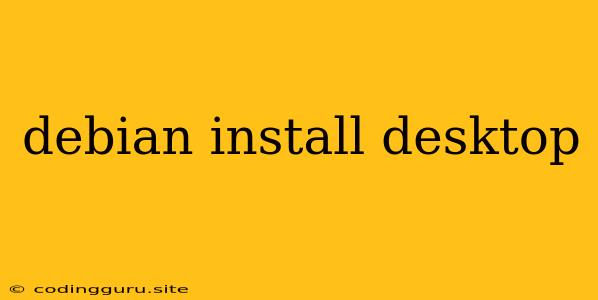Installing a Desktop Environment on Debian
Debian, a widely popular Linux distribution, offers a vast array of desktop environments (DEs) to choose from. Whether you're a seasoned Linux user or a newcomer, picking the right DE can significantly influence your computing experience. This guide will walk you through the process of installing a desktop environment on Debian, focusing on some of the most popular choices.
Why Choose a Desktop Environment?
Before we delve into the installation process, let's understand why you might want to install a desktop environment on your Debian system.
- Graphical User Interface (GUI): DEs provide a user-friendly graphical interface, making navigating and interacting with your system much easier compared to the command line.
- Customization: Most DEs offer extensive customization options, allowing you to tailor the look and feel of your desktop according to your preferences. You can change themes, icons, wallpapers, and even the layout of your desktop.
- Productivity Tools: DEs typically come bundled with a variety of productivity tools, including a file manager, web browser, text editor, and other essential applications.
Choosing the Right Desktop Environment
With so many DEs available, choosing the best one for your needs can feel overwhelming. Here's a quick overview of some of the most popular choices:
- GNOME: Known for its modern, clean interface and intuitive design. It's a good option for users seeking a user-friendly and visually appealing desktop experience.
- KDE Plasma: A feature-rich and highly customizable DE, offering an extensive suite of applications and customization options.
- XFCE: A lightweight and fast DE, ideal for older hardware or systems with limited resources. It's known for its simplicity and ease of use.
- Cinnamon: A fork of GNOME Shell, Cinnamon aims to provide a familiar yet refined desktop experience with a focus on traditional desktop metaphors.
- MATE: Another fork of GNOME 2, MATE prioritizes stability and familiarity for users who prefer the classic GNOME interface.
The Installation Process
Now let's dive into the actual installation process. We'll demonstrate with GNOME as an example.
1. Update Your System:
Before installing any new software, always make sure your Debian system is up to date. Open a terminal and run the following commands:
sudo apt update
sudo apt upgrade
2. Install the GNOME Desktop Environment:
Use the apt package manager to install GNOME:
sudo apt install gnome-session
3. Install Additional Software:
You might want to install additional software that comes with GNOME, such as the GNOME Control Center, a system monitor, and other useful utilities:
sudo apt install gnome-control-center gnome-system-monitor
4. Log Out and Log In:
After the installation is complete, log out of your current session and log back in. You should now see the GNOME desktop environment.
Troubleshooting
If you encounter any issues during the installation process, here are some common troubleshooting steps:
- Verify Connectivity: Ensure you have a stable internet connection.
- Check Package Sources: Double-check that your system is using the correct package repositories.
- Consult the Debian Documentation: Refer to the official Debian documentation for detailed instructions and troubleshooting guides.
Conclusion
Installing a desktop environment on Debian is a straightforward process that can enhance your user experience. By following these steps, you can choose the DE that best suits your needs and enjoy a more visually appealing and user-friendly computing experience. Remember to experiment with different DEs and see which one works best for your workflow.
